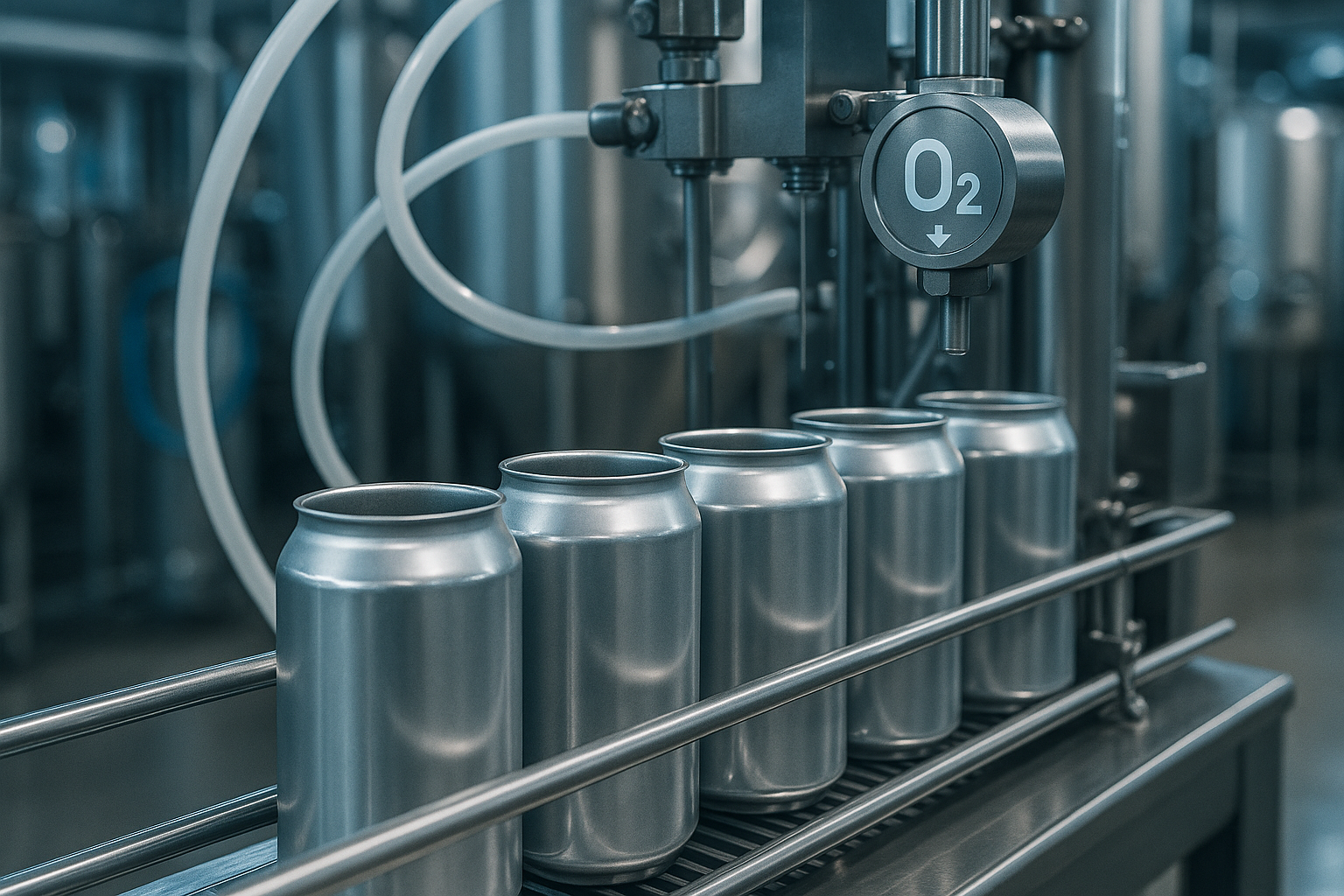
Lowering Dissolved Oxygen (D.O.) During Canning — Step-by-Step
1. Start with product conditioning (the magic trio).
Get temperature, CO₂ volumes, and head pressure dialed. Aim for a thick, creamy
foam pillow just above the can flange before the lid—if it’s clear liquid, it’s not foam, it’s
an over-pour. If foam won’t show up, beer’s likely too cold or under-carbed. Try nudging
temperature up 1° at a time or slightly lowering head pressure. “Foam pulse” is a last
resort, not a lifestyle.
Get temperature, CO₂ volumes, and head pressure dialed. Aim for a thick, creamy
foam pillow just above the can flange before the lid—if it’s clear liquid, it’s not foam, it’s
an over-pour. If foam won’t show up, beer’s likely too cold or under-carbed. Try nudging
temperature up 1° at a time or slightly lowering head pressure. “Foam pulse” is a last
resort, not a lifestyle.
2. Give the canning line its own CO₂ line.
Sharing CO₂ = pressure swings = inconsistent purges. CO₂ is like Wi-Fi: the more you
share, the worse it works.
3. Purge gently: ~10 psi CO₂.
Low and slow from bottom to top. Too hard and you can create a vacuum that pulls air
in. Also...check that regulator isn’t lying to you.
4. Set the CO₂ purge delay.
Typical starting points: ~3–3.5 s for 12 oz, ~4 s for 16 oz. Watch the background blur
trick at can level—when it blurs, the can’s full of CO₂. Too short = incomplete purge; too
long = CO₂ splashing the top and stirring in air.
5. Measure D.O. at the tank.
Know your baseline after CIP/transfer. Pushing sanitizer out with gentle CO₂ helps (keep
purge < 20 psi if you have flow meters). You can’t fix what you don’t measure.
6. Hunt leaks like you hunt off-flavors.
Inspect gaskets, tri-clamps, valve seats, o-rings (fill heads, gland retainers, nozzles). Any
bubbles at the fill-head barb? Trim the hose end ~½" and re-clamp (don’t over-torque).
7. Tame the “frog eyes.”
Big bubbles on the foam cap = air pockets waiting to be trapped. Use low-flow at the start of the pour to shrink them.
8. Dial the twist-rinse water enable delay down.
You want debris out, not free dissolved oxygen in. Less residual water = fewer D.O.
gremlins.
9. Slow the conveyor a touch.
Counterintuitive, but it often doesn’t reduce CPM and gives beer time to gas out (better
foam pillow, better lid pick-up). (Maintenance note: “extend splitter delay” ≈ 0.28–0.30s.)
10. Use lid-chute-full / post-fill splitter delay when needed.
This briefly holds cans after filling so the product can gas out. Might shave a bit off
CPM, but can improve numbers.
11. Check for leaky air cylinders—especially above cans.
Leaky cylinders push air where you least want it. Start with the fill-head cylinders, then
inspect others near the lid dropper and seamer.
12. Set “high-flow raise” timing just right.
Goal: fill head closes at the very top of the pour. Too long → surface drops and sucks
air. Too short → pop-out turbulence. Goldilocks it – in the middle, just right
13. Control fill-head entry speed.
If the head slams in, it blasts CO₂ out of the can and invites air back in. Smooth is
oxygen-free.
If the head slams in, it blasts CO₂ out of the can and invites air back in. Smooth is
oxygen-free.
14. Secure the lid until the seam happens.
Slow belt helps lid retention. Add finesse on the can-push cylinder (use front/rear
cushioning). Shove too hard and the lid shakes or falls; beer sloshes; air sneaks in.
15. Measure D.O. ASAP after seaming.
Don’t wait 20 minutes and then blame the beer. Numbers drift. Measure right away.
16. Obsess (politely) over seam quality.
90% of the seam happens in 1st operation. Measure Op-1 at the start of every run.
Remember: Op-2 can’t fix an Op-1 problem. Inspect or expect leakers.
17. Never soak lids in sanitizer.
You’ll wreck the rubber compound that helps seal tiny seam gaps. Broken gaskets = sad
beer.
18. Avoid moving air.
Close bay doors and hush the overhead ventilation during runs. Air currents disrupt CO₂
blankets and spike D.O.
19. Test with under-lid gassing OFF (if you have it).
Some get great results with it; others see worse foam behavior and more air push-in. Run
a comparison. Low D.O. is possible without the gadget.
20. Use flow meters if you can.
They stabilize volumes despite head-pressure wiggles. Inconsistent headspace =
inconsistent D.O.
Quick sanity checklist (because brew days are busy)
- Thick, creamy foam pillow?
- Purge ~10 psi and timed right?
- Product temp/CO₂/pressure tuned for this exact beer?
- No leaks, no frog eyes, lids stay put, seam Op-1 dialed?
- Measurements taken immediately off the seamer?
Pro tips
- Change one variable at a time and measure in between.
- Most D.O. problems vanish with solid product conditioning.
- When in doubt: slow down, smooth out, foam up.
Good luck and happy canning—may your D.O. be boringly low and your foam delightfully
photogenic.
